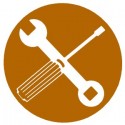Breaking Down Barriers – Overcoming the Stereotypes on Skilled Trades

An article in the Toronto Star by economics columnist Heather Scoffield states that there remains to be a significant difference in how men and women are paid in the country. Women receive between 11 and 31 per cent less than men. To put it in figures, according to Statistics Canada studies, in 2018, female employees aged 25 to 54 earned $4.13 less per hour on average than male employees.
While the government is making efforts to lessen the wage gap, there is an obvious need to do something more than what has already been implemented. Sure, while there are other factors that contribute to this dilemma, it will be good to bring to light possible solutions to address this ever-persistent issue.
A possible solution to explore is to promote women employment in industries that have long been perceived to be men’s territory, such as skilled trades. This is merely one of the perpetual stereotypes on skilled trades that are making women reluctant to join the field or resist it outright.
This is one stigma that Canadian Association of Women in Construction Tammy Evans hopes to eradicate especially since there is an estimated 40,000 shortage of skilled workers by 2030. Evans strongly believes in educating the public and prompting people to think about opening the door to women in the skilled trades and consider careers as masons, plumbers, glaziers, carpenters, ironworkers, steamfitters and sheet metal workers.
Another perception about skilled trades that is difficult to brush off is that it’s an industry for those who aren’t “booksmart” because the tasks rely heavily on one’s physical prowess. However, math and science knowledge and analytical thinking and problem-solving skills are extremely important for any career in the skilled trades, and it’s unfair to assume that skilled trades is solely about physical abilities. A woodworker, for instance, could deal with as much complexity in completing a project just as much as an engineer does. And for professionals who deal with electrical circuits like HVAC technicians, technical knowledge and the ability to be precise and accurate are a must.
In addition, because of the advancements in technology, it has become more critical to be computer-savvy to get a leg up in skilled trades, with some job title options requiring a high level of technical skills. For instance, a carpenter needs to be well-versed in computer software such as AutoCAD (a scientific drawing program) and Cabinet Vision (a design and manufacturing software that caters to those who work with wood), along with being experts in handling like hammers and saws.
Another stigma is that skilled trades is monotonous and limiting, but that can’t be further from the truth. In this industry, there is a variety of tasks such as testing electrical circuits, cutting and fitting pipes, and using a wielding simulator.
It may take a while to break down the stigma on skilled trades, but we’re getting there. We all have to realize that skilled trades deserve utmost respect for the hard work and knowledge and it has the potential to build a stable future for those who choose it.
SOURCES
Buck, Genna. “The tricks – and the stigma – of the trades.” Maclean’s. https://www.macleans.ca/education/college/jobs-report-the-tricks-of-the-trades/
Electrical Industry. “Breaking the Stigma in the Skilled Trades.” https://www.electricalindustry.ca/changing-scenes/452-breaking-the-stigma-in-the-skilled-trades
Ligaya, Armina. “Canada’s gender wage gap narrows: women earn $4.13 less than men per hour.” Global News. https://globalnews.ca/news/6001276/gender-wage-gap-women-canada/
Scoffield, Heather. “Here’s why men still get paid more than women.” Toronto Star. https://www.thestar.com/politics/political-opinion/2020/01/14/heres-why-men-still-get-paid-more-than-women.html.





Leave a comment!